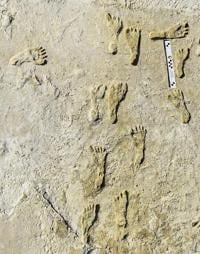New research confirms that fossil human footprints in New Mexico are likely the oldest direct evidence of human presence in the Americas, a finding that upends what many archaeologists thought they knew about when our ancestors arrived in the New World.
The footprints were discovered at the edge of an ancient lakebed in White Sands ��ɫtv Park and date back to between 21,000 and 23,000 years ago, according to research published Thursday in the journal Science.
The estimated was first reported in , but some researchers raised concerns about the dates. Questions focused on whether seeds of aquatic plants used for the original dating may have absorbed ancient carbon from the lake — which could, in theory, throw off radiocarbon dating by thousands of years.
The new study presents two additional lines of evidence for the older date range. It uses two entirely different materials found at the site, ancient conifer pollen and quartz grains.
The reported age of the footprints challenges the once-conventional wisdom that humans didn’t reach the Americas until a few thousand years before rising sea levels covered the Bering land bridge between Russia and Alaska, perhaps about 15,000 years ago.
“This is a subject that’s always been controversial because it’s so significant — it’s about how we understand the last chapter of the peopling of the world,” said Thomas Urban, an archaeological scientist at Cornell University, who was involved in the 2021 study but not the new one.
Thomas Stafford, an independent archaeological geologist in Albuquerque, New Mexico, who was not involved in the study, said he “was a bit skeptical before” but now is convinced.
“If three totally different methods converge around a single age range, that’s really significant,” he said.
The new study isolated about 75,000 grains of pure pollen from the same sedimentary layer that contained the footprints.
“Dating pollen is arduous and nail-biting,” said Kathleen Springer, a research geologist at the United States Geological Survey and a co-author of the new paper. Scientists believe radiocarbon dating of terrestrial plants is more accurate than dating aquatic plants, but there needs to be a large enough sample size to analyze, she said.
The researchers also studied accumulated damage in the crystal lattices of ancient quartz grains to produce an age estimate.
Ancient footprints of any kind — left by humans or megafauna like big cats and dire wolves — can provide archaeologists with a snapshot of a moment in time, recording how people or animals walked or limped along and whether they crossed paths. Animal footprints have also been found at White Sands.
While other archeological sites in the Americas point to similar date ranges — including pendants carved from in Brazil — scientists still question whether such materials really indicate human presence.
“White Sands is unique because there’s no question these footprints were left by people, it’s not ambiguous,” said Jennifer Raff, an anthropological geneticist at the University of Kansas, who was not involved in the study.
___
The Associated Press Health and Science Department receives support from the Howard Hughes Medical Institute’s Science and Educational Media Group. The AP is solely responsible for all content.









































